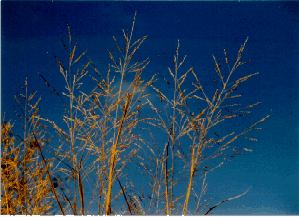 Switch Grass - Panicum virgatum, Switch Grass has an extensive root system and provides wonderful erosion control. This perennial is the earliest maturing of the native warm season grasses. It is widely used for wildlife habitat improvement and readily consumed by livestock. Switch Grass is easily identified by it's wide, large seedhead and prefers lower, moist areas but will do well in drier places. The plants and seeds from Switch Grass provide food for songbirds, pheasants, ducks, geese, wild turkey, cottontail rabbits and muskrats. It can be cut for winter hay. Image Credit: prairiefrontier.com
Switch Grass - Panicum virgatum, Switch Grass has an extensive root system and provides wonderful erosion control. This perennial is the earliest maturing of the native warm season grasses. It is widely used for wildlife habitat improvement and readily consumed by livestock. Switch Grass is easily identified by it's wide, large seedhead and prefers lower, moist areas but will do well in drier places. The plants and seeds from Switch Grass provide food for songbirds, pheasants, ducks, geese, wild turkey, cottontail rabbits and muskrats. It can be cut for winter hay. Image Credit: prairiefrontier.comGrasses 51% Better Ethanol Source Than Corn
In a report found in the Scientific American, a team of economists and ecologists at the University of Minnesota say that “these diverse grassland species [prairie grasses] constitute a carbon-negative source of energy that could alleviate 19 percent of global electricity consumption and 13 percent of the world's petroleum consumption”.
Degraded, nitrogen poor land is best for these types of crops and would require less effort to develop ethanol energy than similar size plots planted in fertile/tended soils planted with corn.
 Virginia Wild Rye - Elymus virginicus, this short lived perennial is often found along marsh edges and in floodplains preferring the damper soils. Virginia Wild Rye will do well in moist and dry sites, shade and full sun, which makes it unique among the prairie grasses. Image Credit: prairiefrontier.com
Virginia Wild Rye - Elymus virginicus, this short lived perennial is often found along marsh edges and in floodplains preferring the damper soils. Virginia Wild Rye will do well in moist and dry sites, shade and full sun, which makes it unique among the prairie grasses. Image Credit: prairiefrontier.comExcerpts from National Convenience Stores Association “online” -
Prairie Grass Could Become a Gasoline Alternative
Scientific American via NACS - December 12, 2006
NEW YORK – A gasoline alternative may be found in prairie grass.
----
Ecologist David Tilman said that in five to seven years, the source of biofuels could expand to include cellulose, a plant sugar known to be an ethanol-rich source. "When we turn that corner," Tilman told the magazine, "we want to have available the most efficient way of producing cellulose to be a biomass feedstock."
Based on his extensive work with crops, Tilman has surmised that nitrogen-poor, degraded land planted with a mixture of perennial prairie grasses – such as goldenrod, Indian grass, big blue stem and switchgrass – could provide up to 238 percent more bioenergy than the same land planted with only one species. He also claims his plots can return 51 percent more energy per acre when compared with ethanol from corn grown in fertile soil.
 Prairie Cordgrass - Spartina pectinata, or sloughgrass, is common in the poorly drained soils or wet prairies and prairie marshes. Prairie Cordgrass has tough thick stems which is reflective of the name and the coarse leaf blades can be quite sharp. Each stem has a long cluster (spike) of branches which holds the individual flower spikelet. This plant spreads agressively by rhizomes and turns golden-yellow in the fall. Image Credit: prairiefrontier.com
Prairie Cordgrass - Spartina pectinata, or sloughgrass, is common in the poorly drained soils or wet prairies and prairie marshes. Prairie Cordgrass has tough thick stems which is reflective of the name and the coarse leaf blades can be quite sharp. Each stem has a long cluster (spike) of branches which holds the individual flower spikelet. This plant spreads agressively by rhizomes and turns golden-yellow in the fall. Image Credit: prairiefrontier.comHis process is reportedly carbon-negative, which means that the plants can store more carbon in their roots than they will create during their conversion to biofuels or electricity. Tilman attributes this negativity to prairie grasses’ complex root systems underground that typically make up two thirds of the plant total biomass, making them efficient carbon sinks. "When they grow, they have to [absorb] a lot of carbon to keep their roots alive and to make these very extensive root systems," Tilman told the magazine. These diverse systems may use more nitrate, "the limiting nutrient" in the soil, which starves bacteria that decomposes carbon, allowing the plants to better maintain their roots.
However, the production of ethanol from grasses is currently hypothetical because of economic constraints.
Read All>>



No comments:
Post a Comment